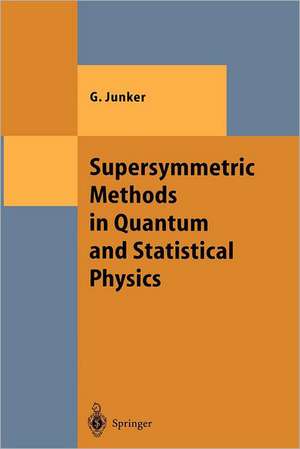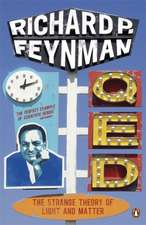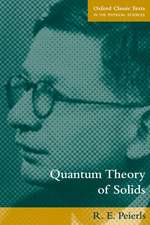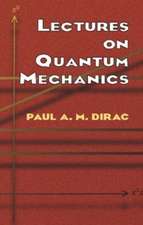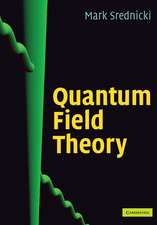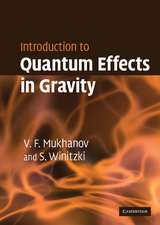Supersymmetric Methods in Quantum and Statistical Physics: Theoretical and Mathematical Physics
Autor Georg Junkeren Limba Engleză Paperback – 19 sep 2011
Din seria Theoretical and Mathematical Physics
- 20%
 Preț: 697.22 lei
Preț: 697.22 lei - 18%
 Preț: 744.84 lei
Preț: 744.84 lei - 20%
 Preț: 699.50 lei
Preț: 699.50 lei -
 Preț: 396.82 lei
Preț: 396.82 lei - 15%
 Preț: 721.06 lei
Preț: 721.06 lei - 18%
 Preț: 1120.68 lei
Preț: 1120.68 lei -
 Preț: 398.35 lei
Preț: 398.35 lei - 15%
 Preț: 643.65 lei
Preț: 643.65 lei - 15%
 Preț: 508.60 lei
Preț: 508.60 lei - 20%
 Preț: 652.54 lei
Preț: 652.54 lei - 15%
 Preț: 646.75 lei
Preț: 646.75 lei - 15%
 Preț: 654.12 lei
Preț: 654.12 lei - 15%
 Preț: 649.87 lei
Preț: 649.87 lei -
 Preț: 396.24 lei
Preț: 396.24 lei - 15%
 Preț: 653.14 lei
Preț: 653.14 lei - 18%
 Preț: 960.78 lei
Preț: 960.78 lei - 15%
 Preț: 529.92 lei
Preț: 529.92 lei - 18%
 Preț: 1127.78 lei
Preț: 1127.78 lei - 18%
 Preț: 1548.71 lei
Preț: 1548.71 lei - 15%
 Preț: 551.53 lei
Preț: 551.53 lei - 18%
 Preț: 1002.75 lei
Preț: 1002.75 lei -
 Preț: 396.02 lei
Preț: 396.02 lei - 15%
 Preț: 648.89 lei
Preț: 648.89 lei - 18%
 Preț: 783.35 lei
Preț: 783.35 lei - 18%
 Preț: 973.38 lei
Preț: 973.38 lei - 18%
 Preț: 907.90 lei
Preț: 907.90 lei - 15%
 Preț: 655.78 lei
Preț: 655.78 lei - 18%
 Preț: 1118.93 lei
Preț: 1118.93 lei -
 Preț: 390.25 lei
Preț: 390.25 lei - 15%
 Preț: 663.79 lei
Preț: 663.79 lei - 15%
 Preț: 653.79 lei
Preț: 653.79 lei - 15%
 Preț: 645.28 lei
Preț: 645.28 lei - 15%
 Preț: 604.23 lei
Preț: 604.23 lei - 15%
 Preț: 639.25 lei
Preț: 639.25 lei - 15%
 Preț: 590.81 lei
Preț: 590.81 lei -
 Preț: 395.25 lei
Preț: 395.25 lei - 15%
 Preț: 589.33 lei
Preț: 589.33 lei - 19%
 Preț: 543.19 lei
Preț: 543.19 lei - 15%
 Preț: 594.24 lei
Preț: 594.24 lei - 18%
 Preț: 911.17 lei
Preț: 911.17 lei - 18%
 Preț: 957.75 lei
Preț: 957.75 lei -
 Preț: 409.13 lei
Preț: 409.13 lei - 15%
 Preț: 532.23 lei
Preț: 532.23 lei
Preț: 382.18 lei
Nou
Puncte Express: 573
Preț estimativ în valută:
73.14€ • 79.42$ • 61.44£
73.14€ • 79.42$ • 61.44£
Carte tipărită la comandă
Livrare economică 23 aprilie-07 mai
Preluare comenzi: 021 569.72.76
Specificații
ISBN-13: 9783642647420
ISBN-10: 3642647421
Pagini: 192
Ilustrații: XIII, 172 p.
Dimensiuni: 155 x 235 x 10 mm
Greutate: 0.28 kg
Ediția:Softcover reprint of the original 1st ed. 1996
Editura: Springer Berlin, Heidelberg
Colecția Springer
Seria Theoretical and Mathematical Physics
Locul publicării:Berlin, Heidelberg, Germany
ISBN-10: 3642647421
Pagini: 192
Ilustrații: XIII, 172 p.
Dimensiuni: 155 x 235 x 10 mm
Greutate: 0.28 kg
Ediția:Softcover reprint of the original 1st ed. 1996
Editura: Springer Berlin, Heidelberg
Colecția Springer
Seria Theoretical and Mathematical Physics
Locul publicării:Berlin, Heidelberg, Germany
Public țintă
ResearchCuprins
1. Introduction.- 2. Supersymmetric Quantum Mechanics.- 2.1 Definition of SUSY Quantum Mechanics.- 2.2 Properties of N = 2 SUSY Quantum Mechanics.- 3. The Witten Model.- 3.1 Witten’s Model and Its Modification.- 3.2 Witten Parity and SUSY Transformation.- 3.3 The SUSY Potential and Zero-Energy States.- 3.4 Broken Versus Good SUSY.- 3.5 Examples.- 4. Supersymmetric Classical Mechanics.- 4.1 Pseudoclassical Models.- 4.2 A Supersymmetric Classical Model.- 4.3 The Classical Dynamics.- 4.4 Discussion of the Fermionic Phase.- 4.5 Quantization.- 5. Exact Solution of Eigenvalue Problems.- 5.1 Supersymmetrization of One-Dimensional Systems.- 5.2 Shape-Invariance and Exact Solutions.- 6. Quasi-Classical Path-Integral Approach.- 6.1 The Path-Integral FormaHsm.- 6.2 Quasi-Classical Quantization Conditions..- 6.3 Quasi-Classical Eigenfunctions.- 6.4 Discussion of the Results.- 7. Supersymmetry in Classical Stochastic Dynamics.- 7.1 Langevin and Fokker-Planck Equation.- 7.2 Supersymmetry of the Fokker-Planck Equation.- 7.3 Supersymmetry of the Langevin Equation.- 7.4 Implications of Supersymmetry.- 8. Supersymmetry in the Pauli and Dirac Equation.- 8.1 Pauli’s Hamiltonian in Two and Three Dimensions.- 8.2 Pauli Paramagnetism of Non-Interacting Electrons, Revisited..- 8.3 The Dirac Hamiltonian and SUSY.- 9. Concluding Remarks and Overview.- References.- Symbols.- Name Index.
Textul de pe ultima copertă
This book gives an introduction to supersymmetric quantum mechanics and a comprehensive review of its applications in quantum and statistical physics. The author discusses the classical and quantum versions of Witten's model and exact spectral properties of the model for the so-called shape invariant potentials. The quasi-classical quantization rules are derived and other topics include the supersymmetric structure of a classical stochastic dynamical system obeying the Langevin or the Fokker-Planck equation, Pauli's Hamiltonian and its application to the paragmagnetism of a non-interacting electron gas in two and three dimensions, and supersymmetry of Dirac's Hamiltonian. The book addresses graduate students as well as scientists.
